Retour à l'accueil > gallery exhibitions
gallery exhibitions

L’œil de poisson
ALI EYAL
From the Creases of my Eyelid, 2024, techniques mixtes
ŒUVRE EN COURS DE CRÉATION
Aux beaux-arts de Bagdad, puis au programme d’Ashkal Alwan à Beyrouth où débute son exil, Ali Eyal a développé une pratique du dessin par accumulation de traits et superposition de figures et d’écrits. Ces images intriquées comme des broderies se propagent d’une simple enveloppe postale à un mur, d’une table à une toile ou à un décor de performance. Elles véhiculent une fiction familiale où les rôles se partagent entre espaces, objets, personnes et faits historiques. Eyal la conçoit comme une scène de crime dont il crypte les indices. Il ouvre et referme des chapitres sans chronologie ni dénouement. Le contexte irakien, les violences coloniales et intérieures, avec les divisions qui en résultent, cohabitent avec des traces de la formation de son regard – il a vu son premier miroir longtemps après les fresques aux murs de sa maison, et juste avant de découvrir la photographie. L’espace le plus sombre de sa propre tête est une camera obscura où il développe la « zone fertile entre l’éveil et le sommeil », comme l’écrit le commissaire de l’exposition tenue au centre Saw, d’où proviennent certains éléments exposés ici. Cet imaginaire féconde un réel invivable et l’enregistre à la fois, inscrivant des gestes de résistance dans des formes poétiques.
Ali Eyal, A Depiction of Things at The Back of My Head, 2021, Huile sur toile
Maison de la littérature
Barbara Manzetti
PourVoirPays, 2024, Papiers, textes
WORK IN PROGRESS
A project which isn't quite a program; rather a voyage into and with the French and other languages. Talismans, spools, inscribed amulets: in this installation, writing is something to be touched, read, skimmed through, glued, unglued, collected, carried around with you. Words, like seeds, are ideally suited to circulate between people, between continents, from one medium to another. Between languages and eras, between voices. Like germs, words lend themselves well to the act of containing. A sound. A meaning. A fragment of the world. From there, they begin to branch out and the buds blossom. They live again. We stretch ourselves out in a sentence. We set ourselves up in tiny openings, between the simultaneous times of the first inhabitants’ languages, of colonial languages, and the languages of everyone who comes to this country. We awaken the words from slumber, from habitual use, from erosion. It has an effect. Removing quotation marks and parentheses from the still-hot ashes. Within her time staying and performing here in Québec, Barbara Manzetti, a writer, performer, and dancer, has been invited to share her experiences from Saint-Denis, France, where she worked with displaced people from various countries, continents, and languages. As Italian who writes in French, Manzetti has come to rediscover the richness of multilingualism.
© Barbara Manzetti, Rester.Étranger, 2021. Photo : Paolo Codeluppi
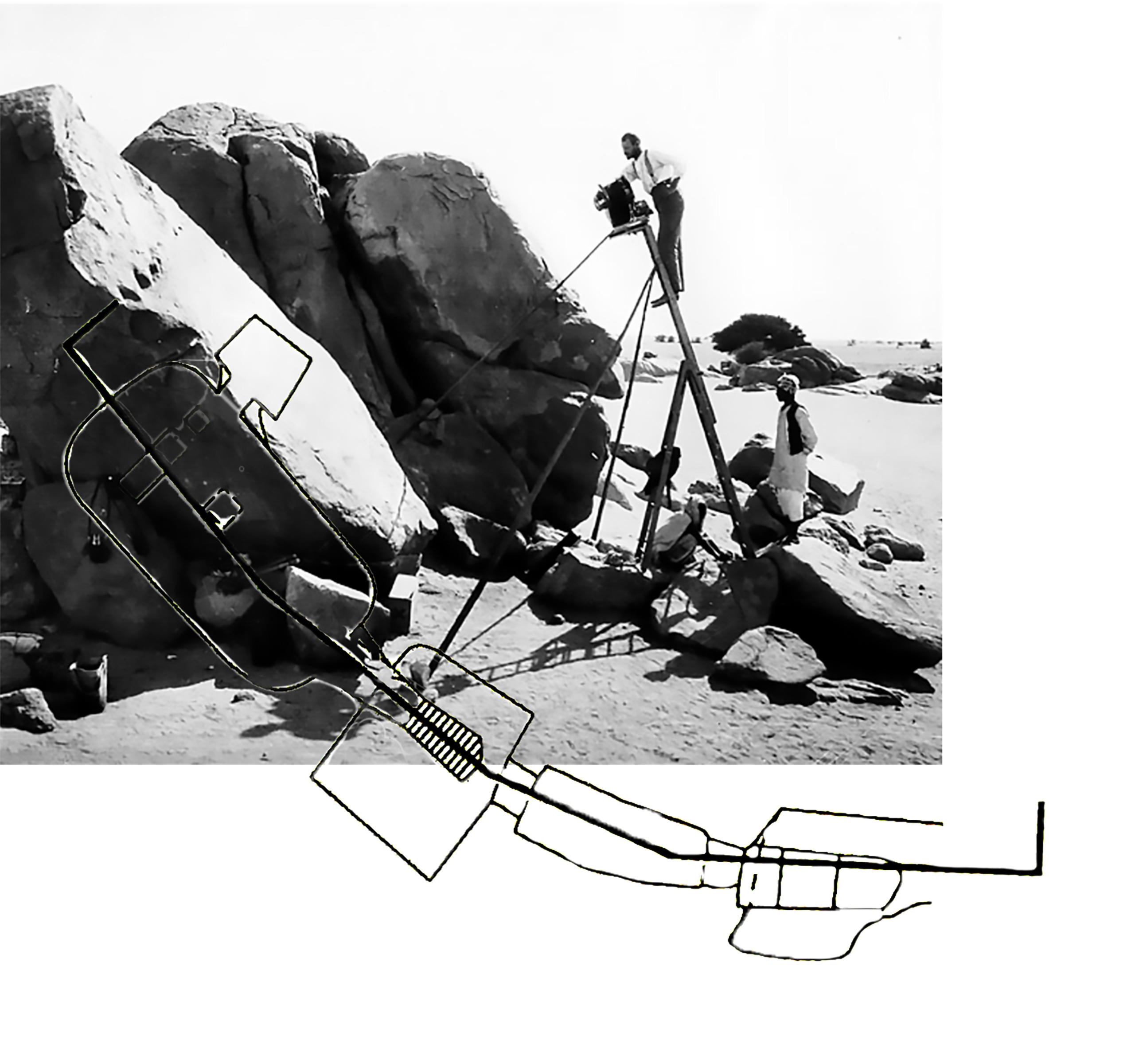
Centre culturel Morrin Centre
dawit l.petros
au rythme du nil ou du chameau, 2023
ŒUVRE EN COURS DE CRÉATION
Au rythme du Nil, ou du chameau est une relecture spéculative d’un événement historique précis : une expédition militaire qui a eu lieu en Égypte en 1884-1885. Conduite par les Britanniques, elle comprenait des membres des Premières Nations, des Canadiens français et des Canadiens de l’Ouest. Tous étaient convoyés sur le Nil avec les troupes britanniques par une flotte de baleiniers. L’objectif était Khartoum, capitale de ce qui était alors une province égyptienne sous domination britannique : le Soudan. Son gouverneur général, le général-major Charles Gordon, était alors attaqué par des troupes indépendantistes inspirées par celui que ses partisans nommaient « le Mahdi », Muhammad Ahmad. Les voyageurs venus du Québec et du Canada ont participé à un autre événement de l’histoire coloniale dans l’Ouest canadien : la Résistance de la Rivière Rouge. L’installation s’inscrit directement dans le contexte de la biennale et de sa présentation dans la bibliothèque du Morrin Center. Elle forme un collage spatial associant sons, images et textes. L’élément central est la bande-son, un montage de musique, de voix hors champ issues de films, de documentaires et de lectures de carnets de voyage. Pour explorer des modalités de réveil de l’histoire et de ses traces, ce mixage associe des éléments de contextes culturels hétérogènes.
© Dawit L. Petros
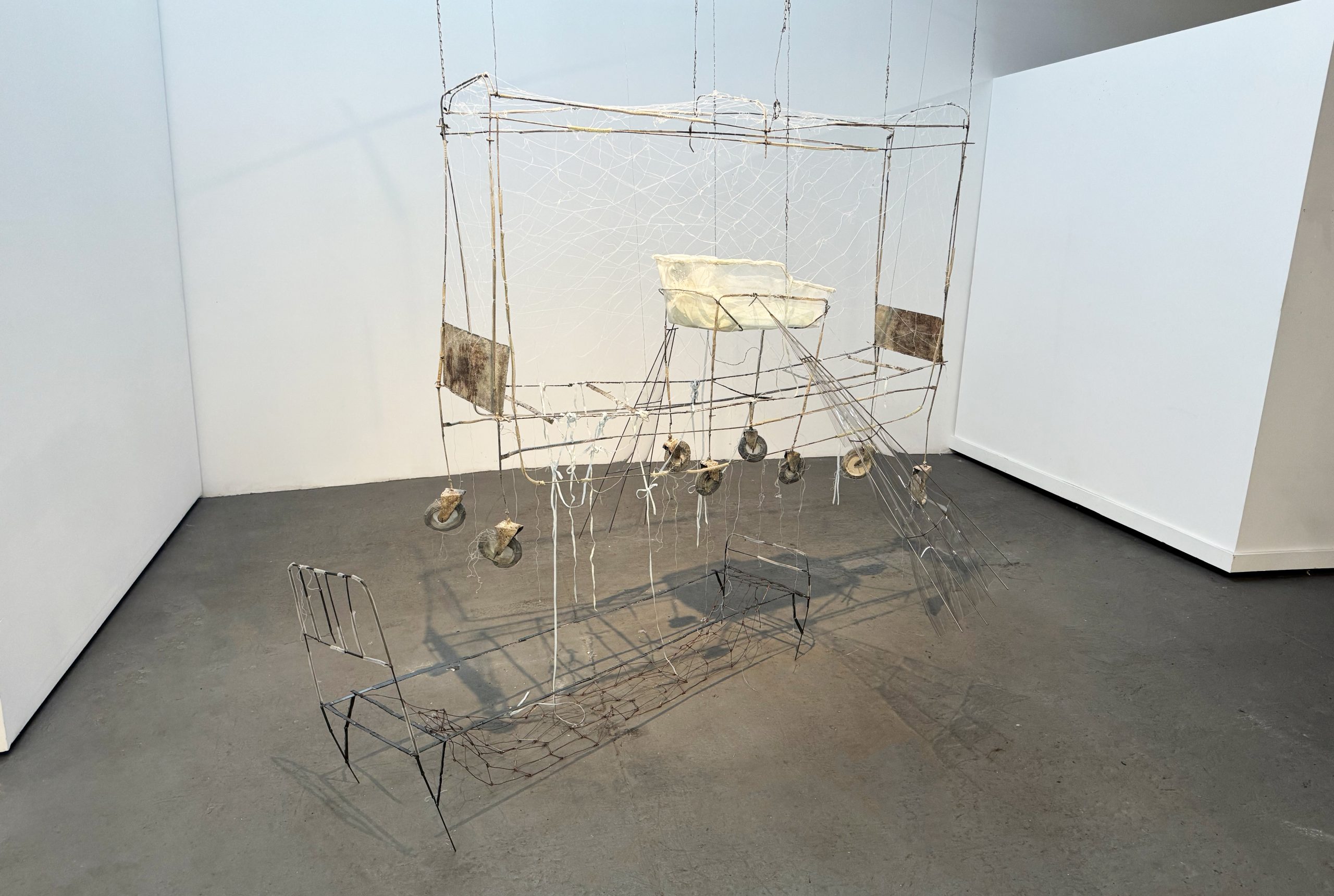
LA CHAMBRE BLANCHE
jannick deslauriers
Cénotaphe, 2023-2024, crinoline, acier, cire d’abeille, vinyle clair
WORK IN PROGRESS
By invoking the cenotaph, a symbolic tomb devoid of remains, Jannick Deslauriens captures the essence of sleep and its elusive nature. The arrangement of the bed in this installation can be interpreted within various contexts, such as a hospital, camp, prison, orphanage, or stretcher. These elements are assembled in a predominantly vertical structure, giving the impression that it stands independently. In her work, the bed becomes an extension of the body—the artist alludes to themes of mutilation and grafting. While she draws a connection between welding with sewing, the makeshift winged prostheses she incorporates evoke the notion that sleep can serve as an escape. Whether representing free or restrained bodies, in moments of rest or anticipation, experiencing pain or pleasure, in private or public settings, these themes resonate throughout the installation.
© Cénotaphe en cours de création. Photo : Neil Hamamoto
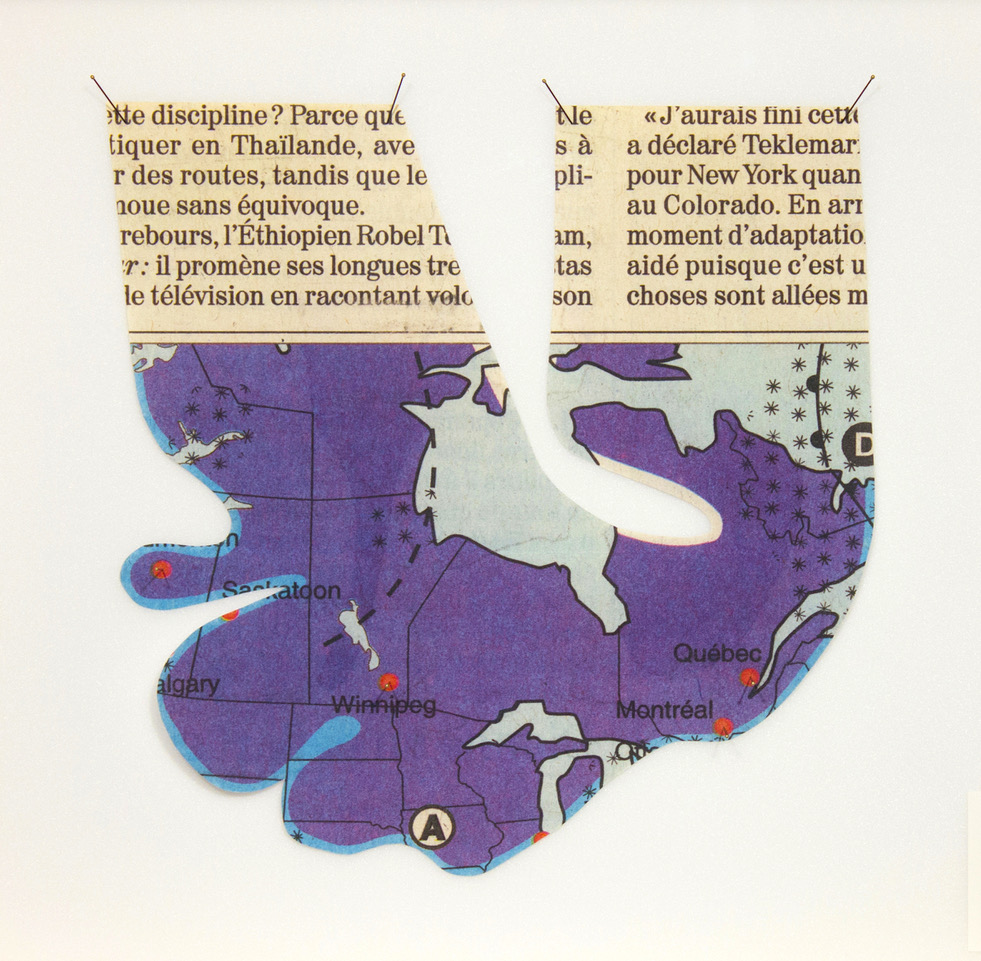
L’œil de poisson
julie picard
Cartes-soleil, 2023, série de 12 cartes météorologiques imprimées sur papier de riz 100 g Hahnemühle sans acide, et épingles émaillées à entomologie
These meteorological maps, published in the local newspaper Le Soleil in 2004, typically displayed daily average temperature, where intense heat is represented as infrared and extreme cold in ultraviolet. Julie Picard has selected and cut out twelve zones, each of which include the city of Québec. For the Biennale, she has digitized and printed the maps, transforming them from their original miniature format to a much larger scale. In doing so, she reveals borders that constantly shift with the seasons and evolving climates. These territories go beyond political and economic boundaries and may even surprise us, like when Québec City shares space with Los Angeles or Miami. Newspaper printing, which has long been the medium of mass culture, is now under threat: in 2023, Le Soleil went entirely digital. The fragility of paper, Picard’s primary material, can now be compared to the state of the environment. Here, Picard unfolds just some of climate change’s pressing issues.
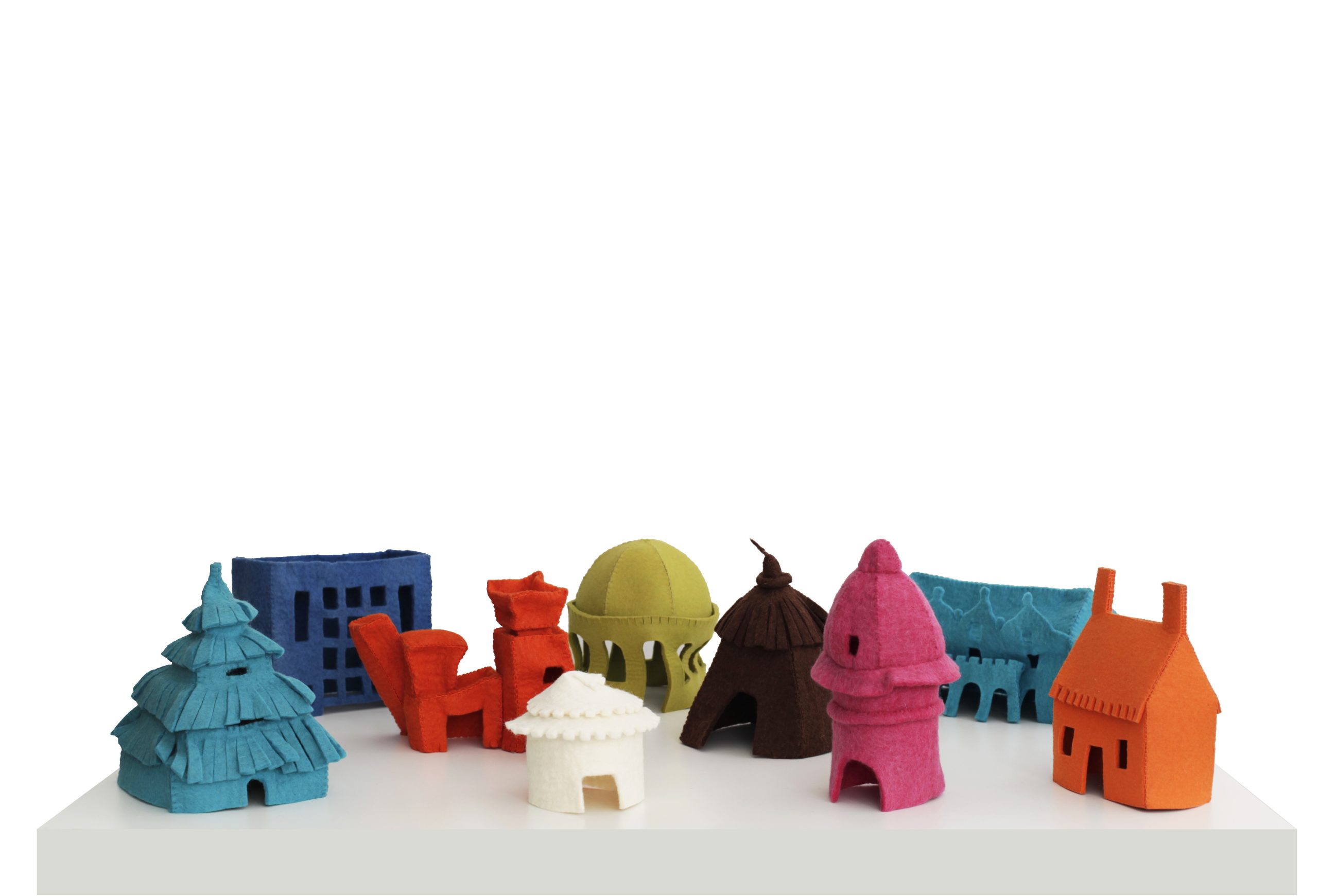
REGART
laure tixier
Plaid Houses, 2007-2011, 48 maquettes de feutre
Unités stratigraphiques, 2023, Aquarelles sur papier
In this sheltered riverside space, Laure Tixier draws a link between entrenchment and childhood. Unlike her outdoor installation, Suspendre, these miniature, brightly coloured and organic "houses" made of felt—an agglomeration of animal fibres—evoke childhood imagination of blanket forts; the artist refers to this as our "first architectural narrative." The reference to the human body that is present in both installations finds a common ground in the watercolours on the wall . With "Plaid Houses," Tixier gathers a diverse range of cultural, geographic, and historical influences, from Mongolian yurts to thatched Brittany houses to postmodern buildings and fortified castles. These soft models carry deeper implications, showing that architecture shapes both; those who inhabit it and those who observe it. This assembly of buildings, placed on an equal footing, tells a story about human communities and their ambitions to plan their living spaces, as the bodies inhabiting them, and, by extension, how it shapes their surroundings; sometimes at the cost their surroundings.
© Photo : Pharoah Marsan
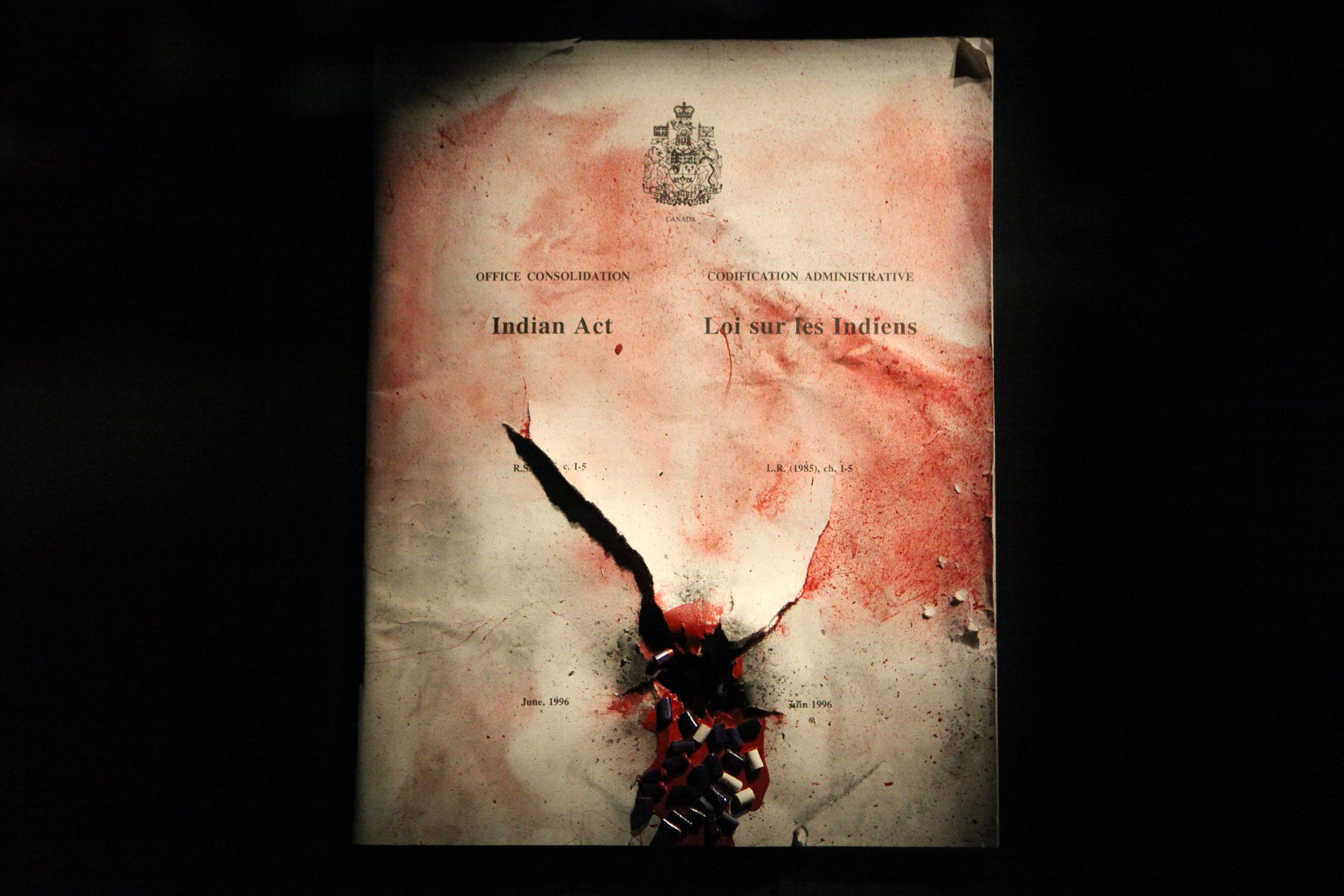
CENTRE D'ARTISTES Ahkwayaonhkeh
Louis-Karl Picard-Sioui
et Teharihulen Michel Savard
Temps et contretemps, 2023-2024, Pierre, bois, fils électriques
WORK IN PROGRESS
At the dawn of the Earth, the spirit-turtle impregnated the mother of the Gods by placing two arrows under her bed, as can be seen represented in the centre of the installation. The mother then gave birth to twins: Iouske’a (order, warmth, regeneration) and Tahwihskaron’ (chaos, cold, death), symbolized here by the two beds. The first bed, made of stones, conveys coldness and hardness; a reminder of the suffering caused by Tahwihskaron’ while also referencing the giant stone cannibals he created, called the Strendu. The second bed, covered in pine boughs, symbolizes the fertile sleep induced by a night in the forest, where the regenerative power of Iouske’a reigns. A linden tree branch serves as both a pillow and, according to mythology, a tool for combatting the Strendu, like the axe of the Skahndawatih. In the centre, a wigwam symbolizes the belly of Mother Earth, the original resting place where the first rhythms of the heart and of the drum were passed down. Through their work, the artists state that a knowledge of mythology can help fight against the forces of breathlessness and cold. However, they also remind us that this is a dance, that these two forces follow a rhythm that has been set since the beginning of time, and that they are inextricably linked.
© TEHARIHULEN MICHEL SAVARD, Réciprocité, 2010. Photo : France Gros-Louis Morin
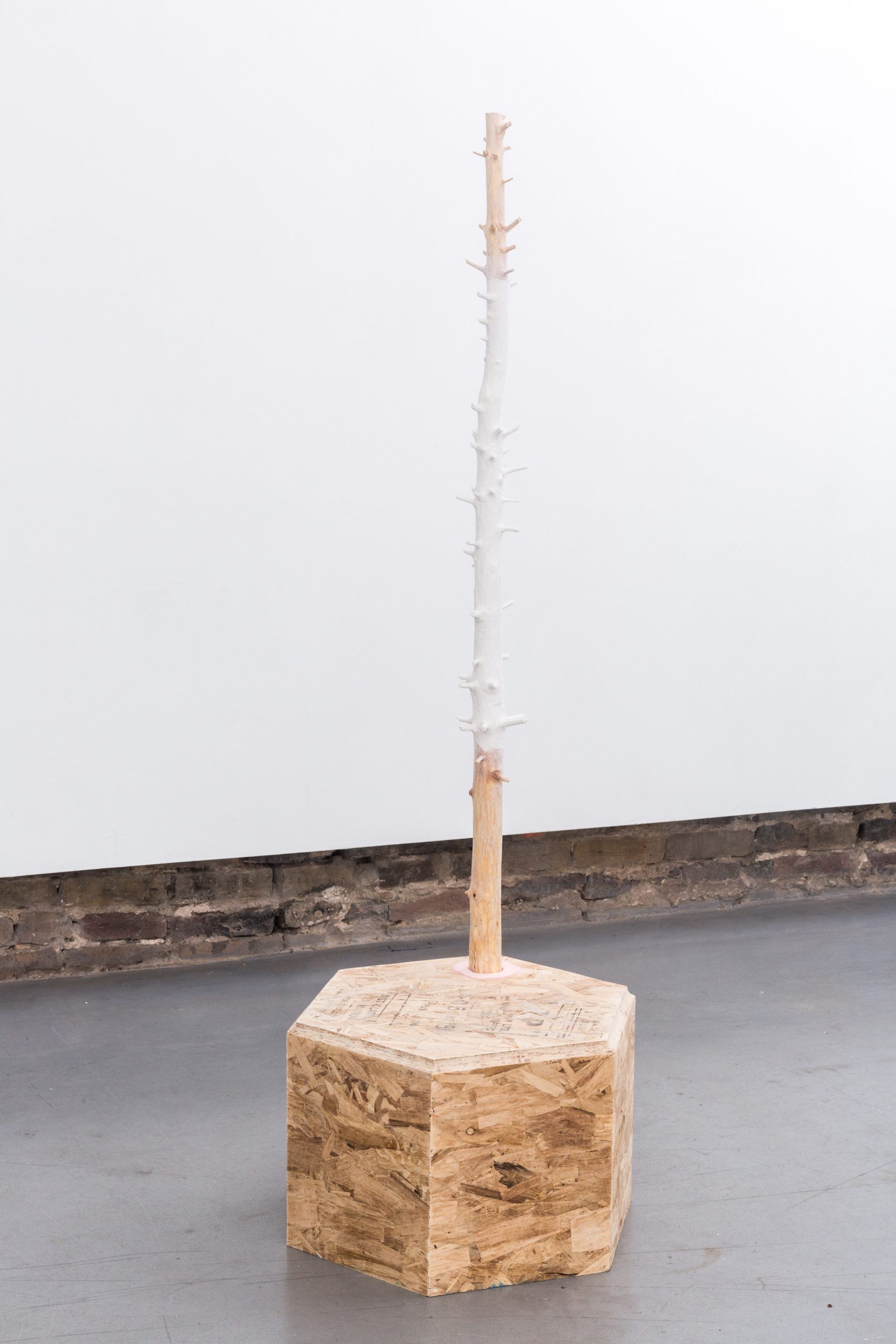
GALERIE DES ARTS VISUELS
magali hébert-huot
Trame - Hatch, 2023-2024, OSB, hydrocal résine polyuréthane, mousse expansée, caoutchouc, stuc
WORK IN PROGRESS
Magali Hébert-Huot compose un paysage de forêt hivernale minimaliste en reconstituant des lames de neige, ou congères, en bois et en stucco, associées à des troncs de sapin comme ceux utilisés dans son installation Abrité - Snug. Certains éléments signalent l’intervention humaine; des agencements entre branches, cordes et pierres évoquent des techniques anciennes de construction de pièges pour la chasse. L’artiste observe avec un humour critique les stéréotypes masculins. Elle reprend certains codes, comme l’utilisation de trophées de chasse en ornementation et la technique d’impression hydrographique, employée pour imprimer des motifs de camouflage sur les armes et les camions. Les artefacts, leur théâtralité, mais aussi la souplesse du caoutchouc et les couleurs fluorescentes représentent la question du genre, particulièrement aiguë dans cette installation. Hébert-Huot déplace, dans le monde végétal et le territoire, des notions liées au corps et aux catégories qu’on lui impose. Le mélange entre éléments végétaux et objets fabriqués crée des tensions entre la reconnaissance du monde tel qu’il est et toute mutation possible. La catégorie du « naturel » ne fonctionne plus, la répartition binaire, culturelle et biologique entre masculin et féminin est caduque. En entreprenant une recomposition queer d’éléments du territoire, Hébert-Huot dérange des modèles culturellement dominants. À nous de trouver notre place.
© Magali Hébert-Huot, Untitled (Stump Noël), 2018, OSB, épinette, floc. Photo : Patrick Harkin
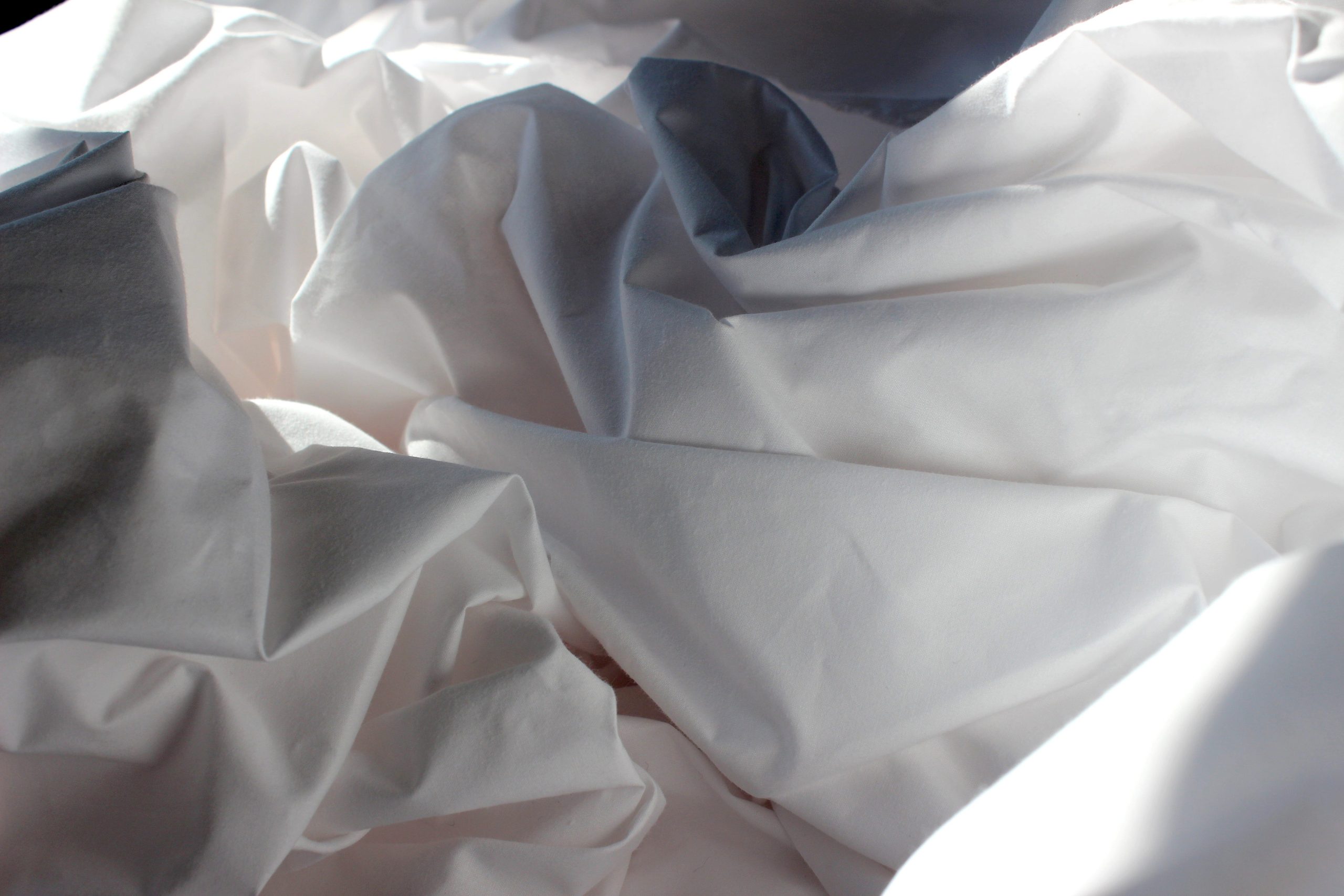
LE LIEU
MARIE-CLAUDE GENDRON
Faire mon lit – Make My Bed, 2024, bois, verre brisé, draps
WORK IN PROGRESS
Huit heures par jour, cinq jours par semaine, un mois durant, Marie-Claude Gendron fait et défait un lit. Les deux semaines suivantes, les traces de cette action restent exposées. Les dimensions du lit sont hors norme. À aucun moment l’artiste ne s’y couche. Les périodes de performance sont comptabilisées sur des cartes indiquant ses heures d’arrivée, de départ et de pause, comme un horaire de travail, près de la porte. Un geste domestique et dévalorisé devient l’objet de l’art. Et, contrairement aux actions de maintenance performées par l’Américaine Mierle Laderman Ukeles dans les années soixante, le geste de Gendron prend sa valeur dans sa répétition. En le reprenant sans cesse et chaque jour, l’artiste « performe » un état qui dénote une légère altération de la conscience, un geste maniaque ou compulsif, absurde. Le contexte l’associe directement à des formes de sommeil éveillé. Le lit est la scène d’un abandon, celui des facultés rationnelles, des gestes, la limite des règlements culturels du corps : en théorie. Ici, il annonce un drame. Comme dans un conte cruel, les multiples draps recouvrent des débris de verre. Le matériau installe un espace d’insécurité et suggère un piège et des blessures.
© Hugo Nadeau
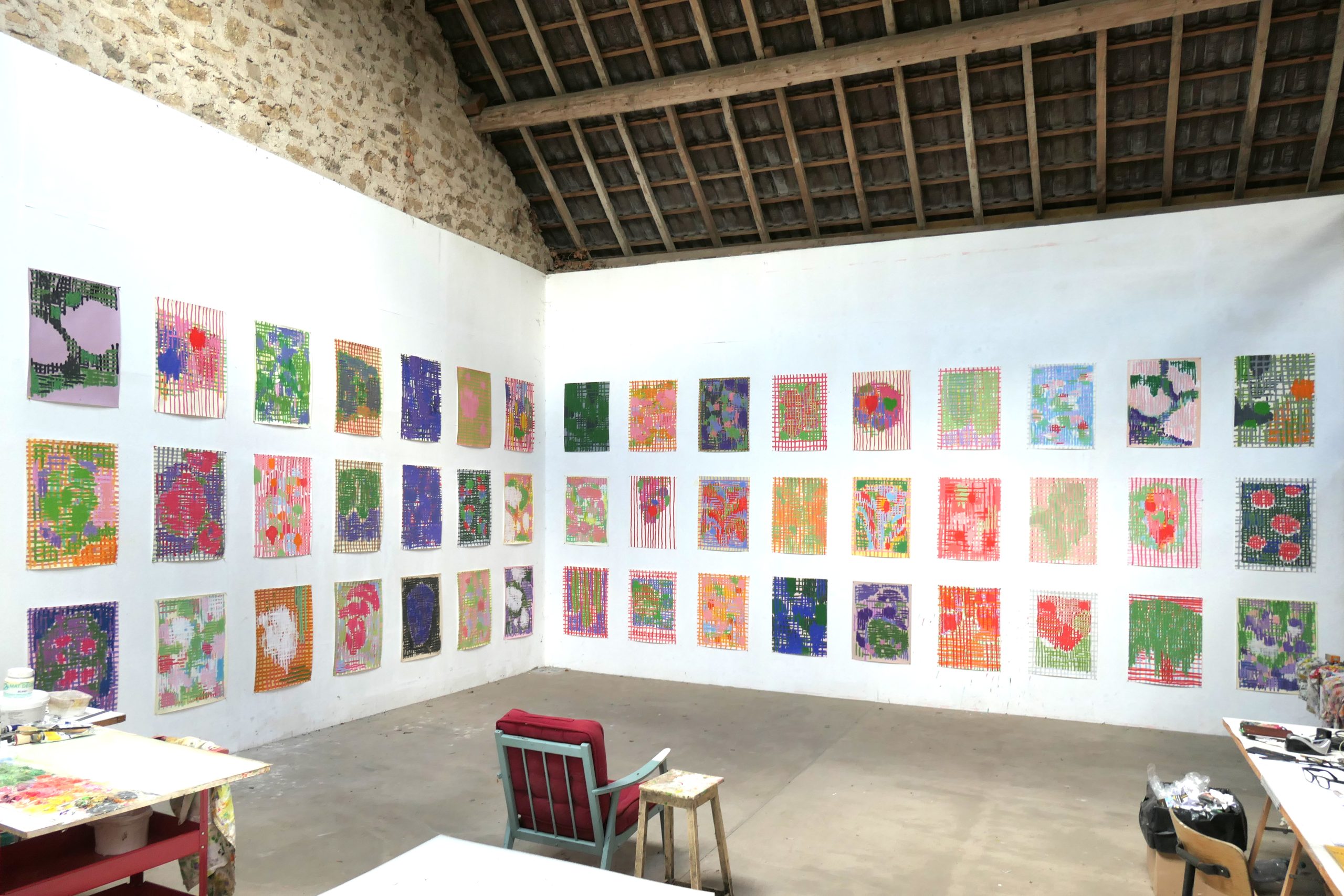
ENGRAMME
paul cox
Fragments, 2024, sérigraphie et acrylique sur papier
Achieving more with less, Paul Cox works with a minimal number of silk-screens featuring orthogonal grids. He overlays these, varying their colours, spacing, and masking, to create a wealth of potentially endless image combinations. The resulting “images” blur the distinction between foreground and background, playing with the concept of figure and ground, resembling a visual weaving. Each layer triggers the next, like in a game of chess, gradually revealing shapes from the superimpositions and their potential disjunctions. The use of grids follows the logic of printing in successive layers, as seen in Cox's books, posters, prints, or set designs. The changing spaces between the grid lines create various effects, such as fades, transparencies, forms, and optical blends. This rhythmic quality represents a chromatic musicality deeply rooted in the history of avant-garde art. This painting characterized by the rarity of flat surfaces, ultimately evokes a specific physical reality—the so-called "incomplete" structure of an atom. At the atomic scale, the space between the nucleus and electrons is vast and empty, with the diameter of an atom being 100,000 times larger than its nucleus. Matter is not continuous but rather perforated, and the world is constructed out of superimposed layers rather than layers of flat planes.
© Paul Cox, Embroideries vue d’atelier, 2023
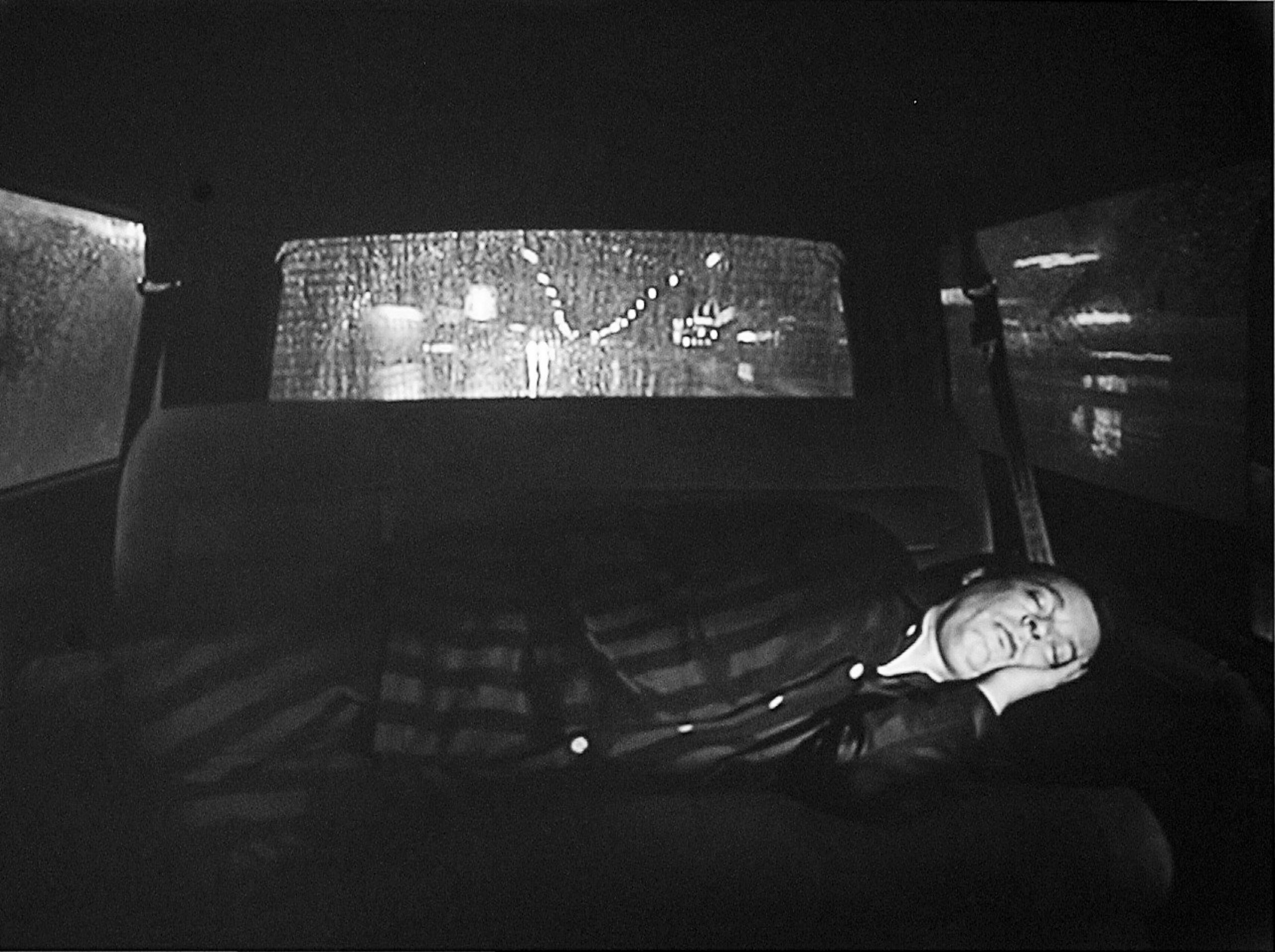
LA BANDE VIDÉO
RODNEY GRAHAM
Halcion Sleep, 1994, 26 minutes, vidéo à un canal
Halcion Sleep is a single-shot, black and white video that documents a performative action in much the same way the medium was first used to record performances during the 1960s. Graham, dressed in pyjamas and fast asleep, is seen lying on the backseat of a car as it drives through the city at night. The sight of traffic lights streaming past the back window provides the impression of a second screen, like the Hollywood film technique of rear projection. The absence of sound suggests a hallucination, while Graham’s deep slumber evokes another type of projection that is inaccessible to us: his dreams. Halcion is the name of a fast-acting sedative that was once popular but is rarely prescribed today. Rodney Graham took 5mg of the drug in a motel room on the outskirts of Vancouver. Once the sedative had taken effect, his brother and a friend drove him back home in the city. Exhibiting himself in a completely vulnerable state, Graham simultaneously subverts the typical narrative of film noir and the myth of the artist as demiurge. This video was Graham’s first moving image piece. It launched several other works in which he features himself—in his 16mm films and lightbox photographs—while evoking the history of cinema and performance with caustic humour.
© The Estate of Rodney Graham

VU
SUZANNE LAFONT
Et toi, chère plante?, 2023, photographie numérique, Impression jet d'encres
Une vingtaine d’images de 230 sur 150 cm font cercle dans le white cube. Toutes sont des photographies de plantes retravaillées : techniquement précises, visuellement dénaturées. Passer à la table lumineuse, agrandir et recadrer chaque fleur ou feuille : le traitement relève d’une métamorphose maîtrisée que le jeu chromatique accentue. Quelques mots les accompagnent. Sur un panneau central, la question : Et toi, chère plante, de quoi es-tu composée? à laquelle chaque image offre une réponse concise. Contrairement à la tradition de l’illustration botanique, le texte n’est pas un équivalent verbal scientifique de l’image. Il n’énonce qu’une des composantes de la plante et l’un de ses dérivés, le plus souvent industriel. Suzanne Lafont s’intéresse depuis toujours aux capacités fictionnelles de la photographie, à la fois geste technique lié à une forme d’exactitude, et expérimentation imprévisible de la lumière. Mis en scène, recadré, séquentiel, scénarisé, habité par des interprètes, le monde qu’elle décrit n’est pas une réplique du nôtre; il le reconstruit avec un humour décapant. Sous des dehors ornementaux, l’herbier dysfonctionnel, avec lequel Lafont opère des variations depuis 2017, se métabolise entre ce que nous voyons et ce que nous lisons. Dans ce passage, il stigmatise des capacités humaines inépuisables et létales d’appropriation et d’exploitation du vivant.
© Suzanne Lafont